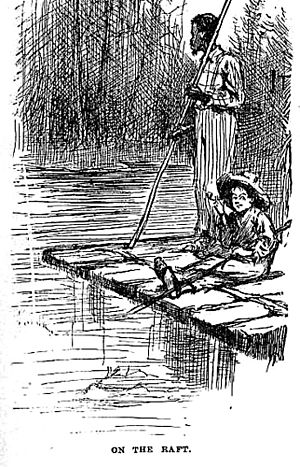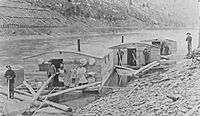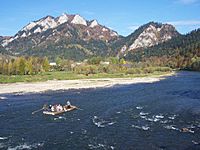Raft facts for kids

A raft is a flat floating platform. It is used to support things or to travel across water. Rafts are usually simple and do not have a deep hull like a boat. They float because they are made of materials that float, like wood or inflated air bags called pontoons. Rafts usually do not have an engine. People have used rafts for a very long time, even since ancient times. They used natural rafts made of floating plants or pieces of wood to cross water.
Contents
Human-Made Rafts: How People Build Them
People have built rafts in many ways throughout history. Early rafts were often made from wood or strong reeds. Today, modern rafts might use pontoons, large drums, or polystyrene foam blocks to float.
Inflatable rafts, which are filled with air, used to be made from animal skins. Now, they are mostly made from strong, layered rubber fabrics. Depending on its size and what it is used for, a raft might have a small shelter, masts for sails, or a rudder to steer.
Timber Rafting: Moving Logs on Water

Timber rafting is a way to move cut logs. Workers tie logs together to form huge rafts. Then, they float or pull these rafts down a river. This method was very common for the logging industry until the mid-1900s. Today, it is used much less often.
Ancient Balsa Rafts: Travel Across Oceans
Large rafts made from balsa wood were very important for trade along the Pacific coast of South America. People used them from ancient times until the 1800s. These rafts had sails and could travel very far, even to places like Mexico. Some people have built copies of these old rafts and sailed them across the Pacific Ocean. This showed that ancient people might have traveled between South America and Polynesia.
Recreational Rafting: Fun on the Water
When people talk about recreational rafting for fun, they usually mean an inflatable raft. These rafts are made from flexible materials. They are designed to be used on exciting whitewater rivers.
Natural Rafts: Nature's Own Boats
In biology, especially when studying island biogeography, natural rafts are a big deal. These are not made by humans. They are thick clumps of vegetation that have been washed off land by events like storms, tsunamis, or earthquakes. Sometimes, they also include other floating trash, like plastic containers.
These natural rafts float because of their natural buoyancy. They can travel for hundreds or even thousands of miles across the ocean. Eventually, they break apart from waves or rot away, or they reach new land.
How Animals Travel on Natural Rafts
Natural rafting events are a very important way for animals that cannot fly to spread across oceans. For small mammals, amphibians, and reptiles, and also for many invertebrates (animals without backbones), these rafts are often the only way they could reach and live on new oceanic islands. This was especially true before humans built vehicles that could travel across the sea.
Image gallery
-
Three Arks for a log drive on Pine Creek, in Pennsylvania. The left ark was for cooking, the middle for sleeping, and the right for horses. They were built for one trip and then sold for their wood.
-
A raft carrying visitors to Tom Sawyer Island at Disneyland, around 1960.
-
People on a raft in Estonia in 1944.
See also
 In Spanish: Balsa (embarcación) para niños
In Spanish: Balsa (embarcación) para niños
- Floating island
- Great Raft
- Kon-Tiki
- L’Égaré II
- La Balsa and Las Balsas
- Lifeboat
- Pre-Columbian rafts
- Pumice raft
- The Raft of the Medusa
- Thor Heyerdahl
- Poon Lim








